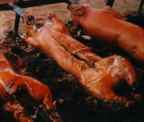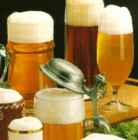Special Feature: Products Sally Recommends
Ethnic Cuisine: Germany
introduction | glossary | recipes | cookbooks | sources | crossword
Germany is a federation of sixteen smaller states: Baden-Wuertenberg (with Stuttgart as the capital); Bayern/Bavaria (with the city of Muenchen/Munich); Brandenburg (with Potsdam); Bremen (with Bremen); Hamburg (with Hamburg); Hessen (with Wiesbaden); Mecklenburg-Vorpommern (with Schwerin); Niedersachsen/Lower Saxonia (with Hannover); Nordrhein-Westphalen (with Duesseldorf); Rheinland-Pfalz (with Mainz); Saarland (with Saarbruecken); Sachsen (with Dresden); Sachsen-Anhalt (with Magdeburg); Schleswig-Holstein (with Kiel); Thueringen (with Erfurt); and Berlin (with the internationally known city of Berlin, which is both capital of the state and capital designate of the country). Germany is located in the heart of Europe and borders Denmark, Poland, the Czech Republic, Austria, Switzerland, France, Luxembourg, Belgium and the Netherlands.
 Germany is not only BMW, Volkswagen, Mercedes-Benz, Braun kitchen appliances, and Kaiser cake pans. It is a land of northern flat and green lowlands, northeastern wide lakes and woodlands, northwestern and eastern rich coal fields, western long and winding rivers flanked by steep sided valleys lined with vineyards, and a southern region famous for its castles, and for events like "Oktoberfest" (Festival of October).
Germany is not only BMW, Volkswagen, Mercedes-Benz, Braun kitchen appliances, and Kaiser cake pans. It is a land of northern flat and green lowlands, northeastern wide lakes and woodlands, northwestern and eastern rich coal fields, western long and winding rivers flanked by steep sided valleys lined with vineyards, and a southern region famous for its castles, and for events like "Oktoberfest" (Festival of October).
Germany is, more importantly, Germans, with their "Gemuetlichkeit" (friendly joviality), their hearty cuisine that has adapted to healthy trends and tastes of recent immigrants, their dairy products and sausage industry, and their cheering spirit, which in time has given impetus to an industry of beers, wines, and distilled spirits, like Hacker-Pschorr and Lowenbrau beers, Asbach Uralt brandies, Joseph Freiderich's wines, and Fuerst Metternich Sekt.
Regional Cuisines
Typical German cuisine varies according to each German state's culinary tradition, to its regional agriculture, and to the new tastes of new Germans who have settled in the reunited Germany. Nordrhein Westfalen, Rheinland-Pfalz, Saarland and Baden-Wuertenburg's traditional specialties, for example, include ingredients typified in the agriculture around the Black Forest and the Rhein river, and by a wine tradition influenced by the proximity to Belgium, France and Switzerland. They include dishes like the "Badener Schneckensuepple" (a snail chowder flavored with herbs), "Schwarzwalder Kirschtorte" (Black Forest cake), and "Rheinischer Sauerbraten" (beef roast stewed with wine).
 Bayern/Bavaria and Hessen's cuisine, with their abundance of beer, meats, and dairy products, feature specialties like "Handkaes" (a smelly type of cheese mixture made with sour cream) and "Schwaebische Kasespaetzle" (small drop-shaped flour dumplings topped with cheese and butter).
Bayern/Bavaria and Hessen's cuisine, with their abundance of beer, meats, and dairy products, feature specialties like "Handkaes" (a smelly type of cheese mixture made with sour cream) and "Schwaebische Kasespaetzle" (small drop-shaped flour dumplings topped with cheese and butter).
Thueringen, Bremen, and the Saxonian states (Niedersachsen/Lower Saxonia-Sachsen-Sachsen Anhalt), include "Dresdner Stollen" (a holiday fruit cake shaped like a wrapped infant and covered with confectioner's sugar), "Blechkuchen" (a simple flat layer of cake dough covered with seasonal fruit), and "Welfenspeise" (vanilla flavored dessert made with wine).
Schleswig Holstein, Hamburg, Mecklenburg-Vorpommern, Brandenburg and Berlin, with their access to the North and Baltic Seas, their availability of spices, and their exchange of culinary know-how with Scandinavian and Eastern countries, include "Rote Gruetze" (fruit soup), "Sauerfleisch" (meat in aspic made with fish gelatin), "Bulletten" (meat balls), "Helgolander Krabbensalat" (Helgoland shrimp salad), and "Soeier" (pickled eggs).
Principal crops grown now throughout the German states and used in its regional way of cooking include hops (Germany is the second largest producer in the world), sugar beets, barley, wheat, potatoes, oats, and rye. Cabbage and carrots are the most important vegetable crops, and apples, pears, currants, strawberries, and raspberries are the most important fruit crops.
 A typical German meal today may include from two to seven courses. It is commonly made up by an appetizer (Vorspeise), a soup (Suppe), a main course (Hauptspeise) with one or two either raw or cooked side dishes (Beilagen). After-meal treats are called "Nachspeise." With a fine meal, Germans drink either beer, wine or "Sekt" (champagnoise type sparkling wine). With their meals, young and old Germans also like to drink soft drinks that have interesting names like "Radler" (literally translated, "bike rider" -- a light beer mixed with lemonade or apple juice) or "Limo" (sweetened sparkling water combined with lemonade).
A typical German meal today may include from two to seven courses. It is commonly made up by an appetizer (Vorspeise), a soup (Suppe), a main course (Hauptspeise) with one or two either raw or cooked side dishes (Beilagen). After-meal treats are called "Nachspeise." With a fine meal, Germans drink either beer, wine or "Sekt" (champagnoise type sparkling wine). With their meals, young and old Germans also like to drink soft drinks that have interesting names like "Radler" (literally translated, "bike rider" -- a light beer mixed with lemonade or apple juice) or "Limo" (sweetened sparkling water combined with lemonade).
Throughout the day, Germans love to drink drip coffee brewed in large automatic coffee makers with either paper or metallic filters, and then serve majestic "Torte" or "Kuchen" (cake). No good German "Hausfrau" would want to be so rude to not serve coffee and cake to her welcomed guests! German coffee is usually lighter in caffeine content compared to Austrian and Italian coffees. When it is very light it is also called "Bluemchenkaffee" (small flower coffee). The tradition of this last term originates from wartime, when real coffee was substituted with the roasted roots of chicory, which has a small blue flower.
more on German Cuisine...
introduction |
glossary |
recipes |
cookbooks |
sources |
crossword
Note: This information was accurate when it was published. Please be sure to confirm all rates and details directly with the businesses in question before making your plans.



